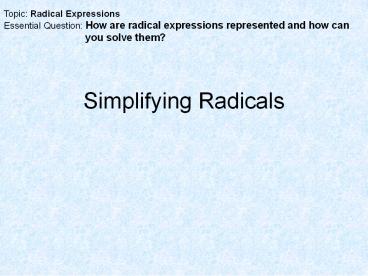Simplifying Radicals - PowerPoint PPT Presentation
Title: Simplifying Radicals
1
Simplifying Radicals
Topic Radical Expressions Essential Question
How are radical expressions represented and how
can you
solve them?
2
What numbers are perfect squares?
- 1 1 1
- 2 2 4
- 3 3 9
- 4 4 16
- 5 5 25
- 6 6 36
- 49, 64, 81, 100, 121, 144, ...
3
A List of Some Perfect Squares
64
225
1
81
256
4
100
289
9
121
16
324
144
25
400
169
36
196
49
625
4
Simplify
2
4
That was easy!
5
10
12
5
Perfect Square Factor Other Factor
Simplify
LEAVE IN RADICAL FORM
6
Perfect Square Factor Other Factor
Simplify
LEAVE IN RADICAL FORM
7
1. Simplify
8
Simplify
- .
- .
- .
- .
9
Combining Radicals
To combine radicals combine the coefficients of
like radicals
Hint In order to combine radicals they must be
like terms
10
Simplify each expression
11
Simplify each expression Simplify each radical
first and then combine.
12
Simplify each expression Simplify each radical
first and then combine.
13
Simplify each expression
14
Simplify each expression
15
Multiplying Radicals
To multiply radicals multiply the coefficients
and then multiply the radicands and then simplify
the remaining radicals.
Hint to multiply radicals they DO NOT need to be
like terms
16
Multiply and then simplify
17
(No Transcript)
18
Dividing Radicals
To divide radicals divide the coefficients,
divide the radicands if possible, and rationalize
the denominator so that no radical remains in the
denominator
19
That was easy!
20
Simplify
Uh oh There is a radical in the denominator!
Whew! It simplified!
21
Simplify
Uh oh Another radical in the denominator!
Whew! It simplified again! I hope they all are
like this!
22
This cannot be divided which leaves the radical
in the denominator. We do not leave radicals in
the denominator. So we need to rationalize by
multiplying the fraction by something so we can
eliminate the radical in the denominator.
42 cannot be simplified, so we are finished.
23
Simplify
Uh oh There is a fraction in the radical!
Since the fraction doesnt reduce, split the
radical up.
How do I get rid of the radical in the
denominator?
Multiply by the fancy one to make the
denominator a perfect square!
24
This can be divided which leaves the radical in
the denominator. We do not leave radicals in the
denominator. So we need to rationalize by
multiplying the fraction by something so we can
eliminate the radical in the denominator.
25
This cannot be divided which leaves the radical
in the denominator. We do not leave radicals in
the denominator. So we need to rationalize by
multiplying the fraction by something so we can
eliminate the radical in the denominator.
Reduce the fraction.
26
Simplify
X
Y3
P2X3Y
2X2Y
5C4D5
27
Simplify
28
Simplify
- .
- .
- .
- .
29
Challenge
Since there are no like terms, you can not
combine.
30
How do you know when a radical problem is done?
- No radicals can be simplified.Example
- There are no fractions in the radical.Example
- There are no radicals in the denominator.Example































